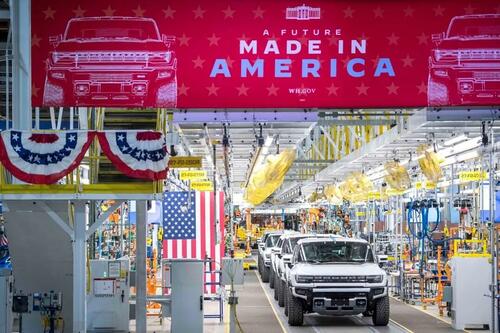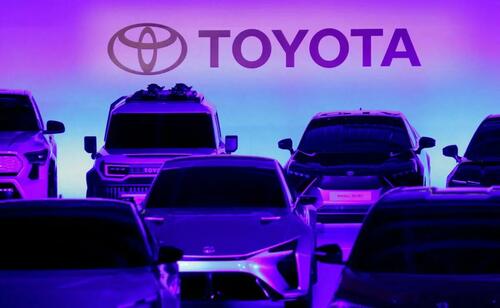While your attention is being focused by war in the East and war in the South, the Globalists are advancing their agenda. A human crime hiding a social crime!
Some people believe that the elites are sold out to the dark side. I am not so sure but you can certainly ask the question.
Authored by Brandon Smith via Alt-Market.us,
As a general rule I find that whenever the public scrutinizes any particular agenda being promoted by governments and globalists their first response is to act indignant, much like a narcissist would do when they are up to no good and they get caught.
“How dare you” question their intentions and suggest they might be nefarious.
How dare you suggest they are anything other than loving and benevolent.
Our “leaders” have only ever wanted the best for us, right?
They only want our lives to become safer, more comfortable and more convenient – This is what truly motivates your average elitist, right?
Obviously history tells us a far different story, and it boggles my mind when anyone tries to argue that things are different today compared to 100 years ago, 300 years ago, or 1000 years ago. There is nothing new under the sun. There will always be tyrants attempting to gain more and more power and those tyrants will always lie to the public, claiming they are good people with our best interests at heart.
When that doesn’t work and the citizenry remains skeptical, the tyrants go on the attack, accusing the public of “conspiracy theory.” This is meant to mock and shame free thinkers into silence – You don’t want to stand out, right? Why risk being ostracized from society? Why risk becoming a meme?
This tactic is rooted in the notion that the corporate media and government officials represent the mainstream, and therefore they represent the majority, and the majority represents reality. None of this is true or relevant, of course. Only facts matter. Sophistry is meaningless. Opinions are meaningless. The truth should be the goal, and if it’s not someone’s goal then they must be a purveyor of lies and should not be taken seriously. There are only two paths to take, there is no in-between.
I will admit there is some value to the “conspiracy theory” accusation because whenever the establishment uses it, it’s a sure sign that you are too close to the target and they are getting nervous. They could simply try to outline any evidence they might have to prove that your position is wrong, but they don’t really do that. Instead of debating your arguments and evidence, they try to undermine you as a valid critic and inoculate the public against your ideas before people ever get a chance to hear them. This is the behavior of villains, not benevolent and caring leaders.
I mention this dynamic because there is one agenda above all others that is aggressively defended by the establishment media, and anyone who remotely questions it is automatically persecuted as a “conspiracy nut” or “denier.” I am of course talking about the climate change agenda.
I have thoroughly debunked the idea of man-made climate change in previous articles and I won’t be spending time on that here.
Instead, I want to examine the end goal of climate change policies – The ultimate solution, which is NOT to save the planet, but to dominate the populace.
The names used for the climate change “reset” vary, but it is often referred to by globalists and the UN as Agenda 2030 or Sustainable Development Goals. These programs wear a facade of environmentalism but they are ALL rooted in economics. That is to say, all climate change efforts exist to destroy industry and trade and establish a government/corporate partnership to dominate production. Climate change is a Trojan Horse to introduce authoritarianism.
I believe one of the most important aspects of Agenda 2030 for globalists is something called the “15 Minute City”; a project which involves hundreds of city mayors from across the US, Europe and Asia working closely with groups like the World Economic Forum. Any mention of this idea in a negative light and the media erupts with anger as well as mockery as if it’s not a real issue worthy of debate.
The establishment paints an interesting picture of 15 Minute Cities – A Utopian future in which everything you need is only a short walk away and private transportation is superfluous (or banned). You might even live in mega-complex, much like a giant mall where you also work. You could spend months within one square mile of space, never having to leave for anything.
It’s no mistake that this idea was pushed hard during the pandemic lockdowns. The public was awash in fear propaganda over a virus with a 99.8% survival rate and that fear made the unthinkable idea of staying at home all the time suddenly thinkable. Media pundits continue to call the connection between covid lockdowns and climate lockdowns a conspiracy theory, but the idea is openly admitted in UN and WEF white papers.
Some people argue that most cities are already “15 Minute Cities” with necessities all within walking distance of their homes. These folks don’t understand what a 15 Minute City really is. As numerous establishment descriptions of the project note, it’s not just about convenience or close access, it’s about changing every aspect of our current philosophy of living. It’s not about gaining amenities, it’s about making an array of sacrifices in order to appease the gods of carbon emissions.
The 15 Minute City is more like a recipe, containing every single ingredient of the climate change and covid lockdown agendas in a single comprehensive Orwellian vision. It includes removing motor vehicles, removing private transportation and roads, smart city and AI monitoring of each person’s electricity usage, monitoring of product consumption and “carbon footprint”, biometric surveillance within a compact and stacked urban landscape, the cashless society concept, equity and inclusion cultism, population control, etc.
It is the culmination, the end game; a massive prison with no bars. A place where you are conditioned to grow accustomed to artificial limitations on privacy, no civil liberties, no private property, and no work options or mobility. You are tied to the land and the land is owned by the state (or corporation). If you want a historic comparison, the closest I can find is the feudal system of Medieval Europe.
Within these cities you are a labor mechanism, nothing more. You will never be allowed to own your own property and thus own your own labor. Everything you have is given to you by the state and can be taken away by the state if you defy them. You might be able to leave the village or community you are tied to for a time, but this will change with increasing restrictions on the public’s movement according to the dictates of climate ideology.
As long as you are productive and submissive you will be give the things you need to survive, but never to thrive. In the case of a technocratic feudal system you would not have any guarantees that the state would need your services. At least in feudal Europe a peasant was seen as valuable resource because of limited population. In a world where many people are considered “population excess”, you could easily be replaced and booted out of the city to starve and die.
In 2016 the World Economic Forum published a document titled ‘Welcome To 2030. I Own Nothing, Have No Privacy, And Life Has Never Been Better.’ The article was meant to promote a concept called the “sharing economy” which was first publicly fielded to the press at Davos. The article describes a “hypothetical” future in which a communistic system has ended all private property in the name of saving the planet from climate change. The benefits? Well, like all communistic systems, the big lie is that you will get to work less and most things will be free. This is how collectivist ideals have been sold to the populace for generations and it NEVER works the way the establishment claims.
The WEF has been promoting the sharing economy for years, but when it went mainstream and was widely criticized as dystopian, the media once again flipped the “conspiracy theory” switch and attacked anyone exposing the implications.
Multiple platforms published the article in 2016 but many have since taken it down (Forbes appears to have erased their published copy, for example). They are pretending as if the agenda never existed, probably because the article contains some revealing admissions, including a hint at the 15 Minute City concept. From the article:
“My biggest concern is all the people who do not live in our city. Those we lost on the way. Those who decided that it became too much, all this technology. Those who felt obsolete and useless when robots and AI took over big parts of our jobs. Those who got upset with the political system and turned against it. They live different kind of lives outside of the city. Some have formed little self-supplying communities. Others just stayed in the empty and abandoned houses in small 19th century villages.
Once in awhile I get annoyed about the fact that I have no real privacy. Nowhere I can go and not be registered. I know that, somewhere, everything I do, think and dream of is recorded. I just hope that nobody will use it against me”
In other words, the globalists imagine a future were the malcontent free thinkers and people replaced by AI are outcasts, scratching and scraping out a meaningless existence in the wastelands of the old world. To stay in the bosom of the new world you will be required to give up all freedom, even freedom of thought. Keep in mind, this article is supposed to be a “positive” promotion of the shared economy and 15 Minute-related cities. Yet, this excerpt sounds more like a threat.
It’s important to understand that these compact cities will not be designed for your comfort. They will not be designed so that you can have all the amenities you have today closer to your fingertips while also providing “sustainability.” That’s how the globalists try to sell it, but that’s not what it will be. Rather, these cities will be designed to better CONTROL you, so that you can be forced to make the sacrifices they say are necessary for sustainability to be possible.
They are erroneously billed as “decentralized communities,” but they are the exact opposite – They are utterly centralized, like a hamster cage where you are the pet. The core philosophy behind them is dependency. If you live in a place which is specifically constructed to eliminate your ability to provide for yourself, then you are a slave. Though, to be sure, even slavery can be made to look noble if people are convinced that their chains are necessary for the good of the planet.









